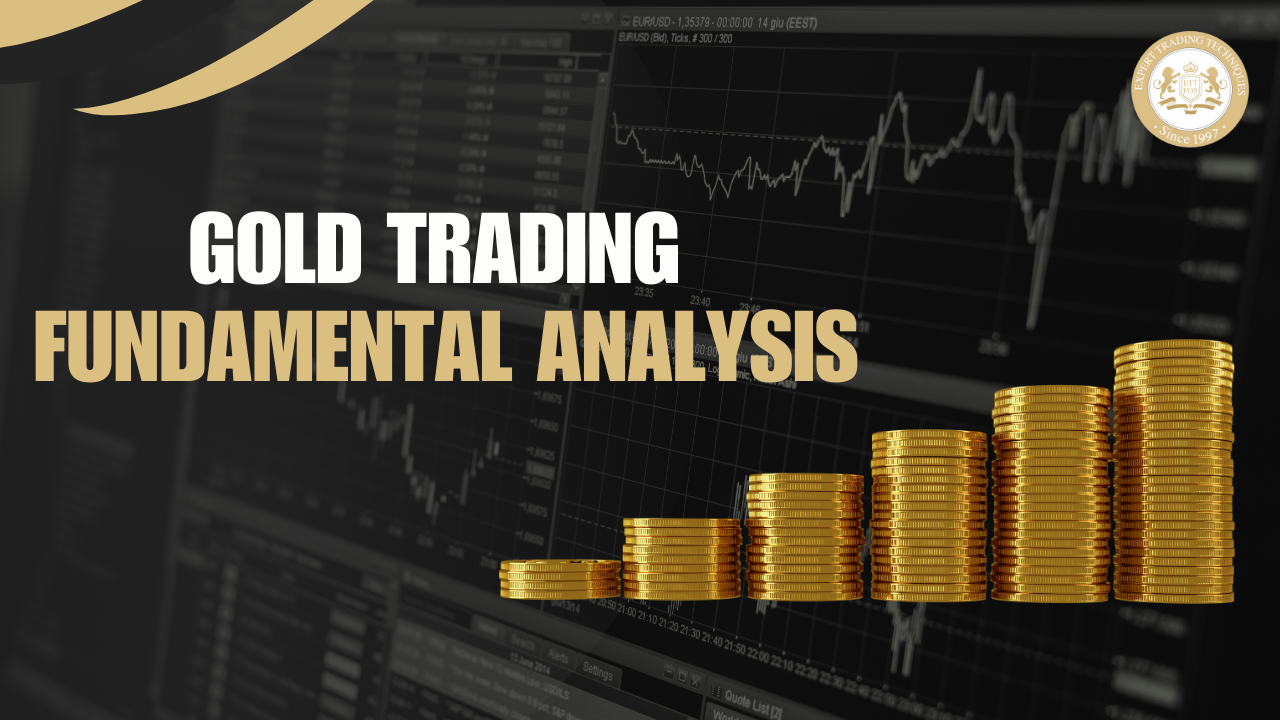
Gold has long been considered a cornerstone of wealth creation, yet many still overlook its potential as a trading asset. While stocks often dominate discussions about investment strategies, gold offers a unique avenue for both stability and profit. In times of economic uncertainty, gold has historically served as a safe haven, drawing investors looking for security and growth. It’s not just about buying gold bars or coins; the trading world opens up a range of possibilities that savvy investors can tap into.
So, how can you navigate the complexities of gold trading? Fundamental analysis is the key. By understanding the factors that drive gold prices, you can make informed decisions that enhance your trading strategies. Here are some essential insights and techniques to help you effectively trade gold and leverage this precious metal to your advantage.
Also Read: What is Gold Scalping

Gold plays a vital role in many investment portfolios today. Many investors see it as a safe place to put their money, especially during uncertain times. When markets are shaky, or inflation rises, gold often holds its value better than other assets like stocks. This makes it a reliable choice for those looking to protect their wealth.
In addition to its stability, gold can also help diversify an investment portfolio. By adding gold to a mix of stocks and bonds, investors can reduce their overall risk. If the stock market goes down, gold might stay steady or even increase in value. This balance can lead to more consistent returns over time. Overall, gold remains a key player in smart investment strategies, helping people safeguard and grow their wealth.

Several key economic indicators directly influence gold prices, making it essential for traders to monitor these factors closely. Understanding how inflation, interest rates, currency strength, and global events impact gold can help investors make smarter decisions. Let’s explore these indicators in more detail.
Inflation is one of the biggest factors influencing gold prices. When inflation rises, the purchasing power of money decreases, which often leads investors to seek gold as a store of value. This increase in demand can push gold prices higher. Similarly, interest rates play a critical role. When interest rates are low, the opportunity cost of holding gold decreases, making it more attractive to investors. As a result, when central banks lower interest rates, gold prices typically rise due to increased buying interest.
The strength of the U.S. dollar is another key factor affecting gold prices. Gold is usually priced in dollars, so when the dollar weakens against other currencies, gold becomes cheaper for international buyers. This can lead to increased demand and higher prices. Conversely, if the dollar strengthens, gold may become more expensive for foreign investors, potentially driving prices down. Tracking currency movements is essential for anyone looking to understand gold price trends.
Global events can have a significant impact on gold prices. Political instability, natural disasters, and economic crises often lead to uncertainty, which drives investors toward gold as a safe haven. For instance, during times of conflict or financial turmoil, demand for gold usually surges, pushing prices higher. Keeping an eye on global news and economic developments can help traders anticipate price movements in the gold market. Understanding these factors is crucial for making informed trading decisions.
Also Read: The Ultimate Guide to Day Trading Scalping for Beginners

To successfully trade in gold, it’s important to grasp the key factors that drive its prices. By understanding what influences the market, you can make more informed decisions and improve your trading outcomes. Here are some essential tips to guide you in your gold trading strategy and journey.
One of the most crucial keys to trading in gold is understanding the factors that influence its prices. Three main elements affect gold: inflation, investor sentiment, and supply and demand. When inflation rates rise, many investors flock to gold, viewing it as a way to protect their wealth, which can cause prices to spike. Similarly, positive sentiment toward gold can drive prices up, while negative sentiment can have the opposite effect. Lastly, when demand exceeds supply, gold prices typically rise, and when supply outstrips demand, prices tend to fall. Knowing these factors can help you make smarter trading decisions.
Geopolitical factors also play a significant role in gold trading. Tensions and uncertainty in the global landscape often lead investors to seek safe havens, driving gold prices higher. Additionally, gold is closely linked to the strength of the U.S. dollar and other major currencies. When currency markets face turmoil, investors usually turn to gold for stability, which can further boost its price. Therefore, it’s essential to stay updated on current geopolitical events before making any trading moves.
Technical indicators can provide valuable insights into gold price movements. Tools like chart patterns, Relative Strength Index (RSI), and moving averages can help you predict future trends. By analyzing these indicators, you can make more informed decisions about when to buy or sell, reducing the risk of losses and increasing your chances of profit.
Monitoring gold production is another effective strategy. Higher production levels usually indicate greater supply, which can lead to lower prices. Conversely, if production decreases, supply tightens, often pushing prices upward. Keeping an eye on production trends can give you a clearer picture of potential price movements, helping you plan your trades more effectively. By combining these strategies, you can navigate the gold market with greater confidence and skill.
Also Read: How to Excel at Options Trading Scalping

To effectively trade gold, it’s essential to use fundamental analysis techniques that can provide deeper insights into market dynamics. By examining factors like supply and demand, central bank actions, and market sentiment, you can make more informed trading decisions. Here are some key techniques to consider when analyzing the gold market.
Understanding the supply and demand dynamics is crucial when trading gold. When demand for gold exceeds its supply, prices tend to rise. This can happen during times of economic uncertainty or when inflation increases, prompting more investors to buy gold. On the other hand, if there is more supply than demand, prices can drop. Keeping an eye on market trends and news can help you anticipate these shifts.
Gold Mining Production Trends: Gold mining production plays a significant role in determining supply. If mining output increases, it usually leads to a higher supply of gold, which can push prices down. Conversely, if production declines due to factors like lower ore grades or mining challenges, the supply tightens, potentially driving prices up. Tracking production reports from major mining countries can give you insights into future price movements.
Central Bank Policies and Reserves: Central banks also impact gold prices through their policies and reserves. When central banks buy gold to increase their reserves, it often signals confidence in gold as a stable asset, which can drive prices up. Conversely, if a central bank sells gold, it can lead to a decrease in prices. Monitoring central bank activities and their gold holdings can provide valuable information for traders.
Market sentiment is another important factor in gold trading. Indicators like the Commitment of Traders (COT) report can show whether investors are bullish or bearish on gold. If more traders are optimistic about gold, prices are likely to rise. Understanding market sentiment can help you align your trading strategy with the current mood of the market.
Both technical and fundamental analysis are essential for successful gold trading. Technical analysis focuses on price movements and patterns, using tools like charts and indicators to predict future trends. Fundamental analysis, on the other hand, looks at economic factors, supply and demand, and geopolitical events that influence gold prices. Combining both approaches can provide a well-rounded perspective and help you make more informed trading decisions. By applying these techniques, you can enhance your understanding of the gold market and improve your trading success.
Also Read: Forex Scalping Strategies

To conduct a thorough fundamental analysis of gold, it’s important to consider several key factors that influence its price. These factors range from central bank policies to currency fluctuations and even seasonal demand. Understanding these elements can provide valuable insights for making informed trading decisions in the gold market.
Central banks hold significant reserves of both paper currency and gold, and these reserves play a crucial role in gold pricing. When central banks diversify their assets away from paper currency and towards gold, it generally drives gold prices higher. Since the U.S. abandoned the gold standard in 1971, central banks worldwide have increased their gold holdings, reaching near 50-year highs. For example, in 2019, governments purchased about 650 tons of gold, showing sustained interest in this precious metal. Countries like Turkey, Russia, Poland, and China were among the largest buyers, indicating a global trend toward gold accumulation.
Gold is priced in U.S. dollars, creating an inverse relationship between the dollar’s value and gold prices. When the dollar strengthens, gold prices tend to fall because it becomes more expensive for investors using other currencies. Conversely, a weaker dollar makes gold cheaper for these buyers, increasing demand and driving up prices. Additionally, as the dollar loses value, investors often seek safe havens like gold to protect their wealth, especially during inflationary periods when rising prices erode the dollar’s value.
Interest rates also have a significant impact on gold prices. Generally, there is a negative relationship between rising interest rates and gold prices. When interest rates increase, it often signals a strong economy, which can lead to inflation. As traders move toward fixed-income investments for better returns, the demand for gold may decrease, causing prices to stabilize or drop. In contrast, lower interest rates typically encourage investment in gold as a hedge against inflation.
In countries like India, rural demand for gold is a major driver of overall consumption. The agricultural sector, influenced heavily by monsoon seasons, affects how much gold is bought. During good harvests, farmers are more likely to purchase gold as a store of value, while poor harvests can lead them to sell gold for cash. This cycle highlights the seasonal nature of gold demand and its dependency on rural economic conditions.
In India, the relationship between the Indian rupee and the U.S. dollar significantly impacts gold prices. When the rupee weakens against the dollar, gold becomes more expensive for Indian buyers, even if global prices remain stable. This fluctuation can reduce local demand for gold, demonstrating how currency exchange rates influence gold markets, especially in import-heavy countries.
Gold is often seen as a safe haven during uncertain economic times. As people look to protect their wealth from market volatility, they tend to invest in gold. This behavior increases during periods of economic or political instability, as investors prefer tangible assets. Gold’s allure as a stable investment remains strong, regardless of whether the economy is thriving or facing challenges, making it a key factor in its fundamental analysis.
Also Read: How to Develop Winning Futures Trading Strategies

When it comes to trading gold, having a solid strategy is essential for success. Different trading methods can suit various goals and risk tolerances, so it’s important to understand the options available. Here are some practical trading strategies to consider for your gold investments.
Spot trading and futures trading are two popular ways to invest in gold. In spot trading, you buy or sell gold for immediate delivery at the current market price. This method is straightforward and ideal for those wanting to own physical gold right away. On the other hand, futures trading involves contracts that agree to buy or sell gold at a set price on a future date. This approach can help protect against price changes but requires a good understanding of the market and carries more risk.
Exchange-Traded Funds (ETFs) offer an easy way to invest in gold without needing to buy physical metal. When you buy a gold ETF, you are purchasing shares that represent a certain amount of gold. These shares are traded on stock exchanges, making them easy to buy and sell. This option is particularly appealing for those who want exposure to gold prices without the hassle of storage or insurance.
Choosing between long-term and short-term trading strategies is crucial for success in gold trading. Long-term traders hold their investments for months or even years, relying on fundamental factors like economic trends to guide their decisions. This approach can help you weather market ups and downs. In contrast, short-term traders focus on quick profits from daily or weekly price fluctuations. This method requires active monitoring of the market and can be more stressful, but it offers opportunities for rapid gains. Understanding your investment goals will help you decide which strategy suits you best.
Also read: The Hidden Costs of Trading
In summary, fundamental analysis is crucial for anyone interested in gold trading. Understanding the factors that influence gold prices, like economic indicators, geopolitical events, and market sentiment, can help you make more informed decisions. With over a decade of experience in this field, I’ve seen how these insights can significantly improve trading outcomes.
Remember, keeping an eye on the broader economic picture can give you a competitive edge. I encourage you to dive deeper into these strategies and incorporate them into your trading practices.
If you’re looking to enhance your knowledge further, consider exploring resources like ETTFOS, which offers valuable insights and tools for traders. Don’t forget to subscribe for updates so you can stay informed and continue learning! Happy trading!
Also Read: Day Trading vs. Position Trading
Gold prices are primarily influenced by supply and demand dynamics, inflation rates, currency strength (especially the US dollar), interest rates, and geopolitical tensions. Additionally, central bank policies and market sentiment can significantly affect gold’s market value.
To trade gold effectively, start by educating yourself about different trading methods, such as futures, ETFs, or physical gold. Create a trading plan that includes risk management strategies, set clear goals, and choose a reputable broker. Staying informed about market trends and economic indicators is crucial.
Gold trading carries risks such as price volatility, which can lead to significant losses, and the impact of economic changes on market demand. Additionally, leverage can amplify losses, and geopolitical events can cause sudden price fluctuations. Understanding these risks is essential for successful trading.